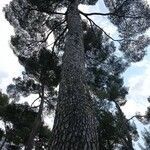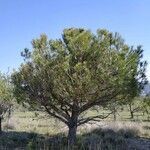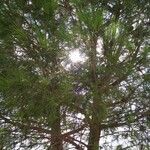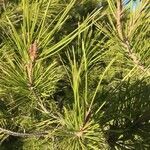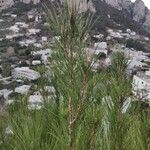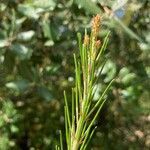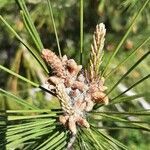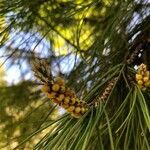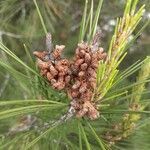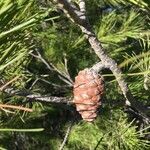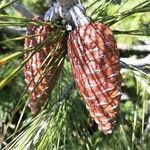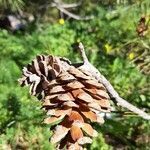Tree, 20-25 m high; bark grey, fissured, exposing reddish brown inner bark. Crown dome-shaped or flat-topped. Leaves: 2 needles per fascicle; sheath persistent, fragile, 8 mm long; needle 50-l50 mm; slender; often curved or twisted (apex short, horny, pointed). Spring shoots smooth, glaucous, glabrous; young twigs ridged. Winter buds 8 mm long, conical, not resinous. Branchlets slender, smooth; leaves spread sparsely along branchlets. Cones pendent on branchlets, singly, in pairs or in threes; indehiscent; often serotinous; persistent for several years; pedunculate; glossy yellowish, reddish or purplish brown; symmetrical, ovoid, 60-120 x 40-70 mm; scales 25 x 16 mm; lustrous, red-brown. Seeds 6-7 mm long, black, winged.
Tree to 25 m tall, with a dense, round crown. Bark purplish brown, persistent, broken into narrow flat plates and pale brown fissures. Resting buds conical, 5-10 mm long, pale brown, non-resinous, with fringed, apically reflexed, persistent scales. Leaves dull, grey-green, finely toothed, 5-9 cm long, in bundles of 2, with 6 or more external and medial resin canals; basal sheath 6-10 mm long. Female cones ovoid-conical, pedunculate, pendulous, symmetrical, 5-11 cm long, often persisting for 1-several years after maturity; scales obovate, not spinose. Seeds with a well-developed wing.
Up to 20 m; crown rounded; trunk and branches often crooked; bark silvery-grey, becoming reddish-brown and deeply fissured. Twigs glabrous, remaining light grey for many years. Buds not resinous. Leaves 60-150 x 0-7 mm, in pairs, slender, clear green, with 1-3 layers of hypodermal cells; resin-canals 3-8, submarginal (sometimes with 1-2 median). Cone 5-12 x 4 cm, shining, brown; apophysis convex; peduncle 1-2 cm, recurved. Seed c. 7 mm; wing c. 20 mm.
An evergreen tree. It grows to 12-20 m high and spreads to 4-6 m across. The stem is twisted and branching. The crown of the tree is like a cone but it becomes more rounded with age. The bark is ash grey. The bark becomes reddish with age. The leaves are like green needles. They are arranged in pairs and bright green. They are 6-11 cm long. The cones are oval. The female cones are 5-12 cm long.
Coniferous tree, up to 20 m high, conical with an open crown. Trunk short when young, crooked when older. Bark silvery grey becoming darker. Leaves needle-like, in bundles of two, blade 40-80 mm long, slender and stiff, grey-green to yellowish green. Cones: conic-ovoid, 80100 mm long, clustered on stout, reflexed stalks; scales flat or slightly raised along a transverse ridge.
